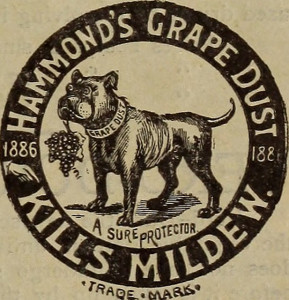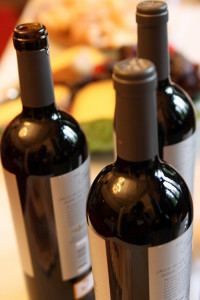In conventional agriculture, as well as in viticulture, fungicides are sometimes used in order to control various fungal pests that can damage or destroy the crop, leading to reduced finished wine quality. Studies have shown that residues from these fungicides can accumulate on the grapes and potentially make it in to the finished wine, which could present significant health risks if present in high enough amounts. As a result of  this, maximum allowed limits have been established throughout the world, in an effort to reduce human exposure to the harmful chemicals that make up conventional fungicide treatments.
this, maximum allowed limits have been established throughout the world, in an effort to reduce human exposure to the harmful chemicals that make up conventional fungicide treatments.
In addition to human health hazards, fungicide residues on grapes have been found to disrupt the winemaking process, specifically in regards to fermentation. Studies have shown that certain (but not all) fungicides can affect yeasts, resulting in either slowed or completely stopped fermentations. These disruptions can have significantly negative impacts on wine aroma, flavor, and overall wine quality. Because of this, there are many newer fungicide formulations on the market that aim to avoid interactions with yeast fermentation processes.
While there is a good amount of data out there on the more “traditional” fungicides on the market, not nearly as much is known about newer fungicide formulations that are designed to not interact with wine yeasts during the fermentation process. As such, a new study published in the journal Food Chemistry aimed to examine the effect of these newer fungicide formulations on the aromatic quality of wine made from exposed grapes.
Results
Alcohols
- Isobutanol levels were higher in wines made from grapes treated with fluquinconzole and kresoxim-methyl compared to the control.
- Isoamyl alcohol levels were higher in wines made from grapes treated with kresoxim-methyl compared to the control.
- 2-Phenylethanol levels were higher in wines made from grapes treated with quinoxyfen compared to the control.
- N-hexanol levels were higher in wines made from grapes treated with famoxadone, kresoxim-methyl, and trifloxystrobin compared to the control.
- No other differences were seen in wines made from grapes treated with various fungicides compared with the control (no fungicide) wines.
Esters
- Isoamyl acetate levels were higher in wines made from grapes treated with kresoxim-methyl compared with all other wines.
- 2-Phenylethyl acetate levels were higher in wines made from grapes treated with kresoxim-methyl and quinoxyfen compared with all other wines.
- Ethyl decanoate levels were higher in wines made from grapes treated with famoxadone, fluquinconazole, and kresoxim-methyl compared with all other wines.
- Ethyl decanoate levels were lower in wines made from grapes treated with fenhexamid compared with the control wines.
- No other esters were different between wines treated with fungicides compared with the control wines.

Photo by Flickr user Internet Archive Book Images (http://www.flickr.com/photos/internetarchivebookimages/14793392213)
Other Compounds
- Fatty acid levels were statistically similar between wines made with grapes from all fungicide treatments.
- Octanoic acid levels were lower in wines made from grapes treated with famoxadone compared with the control (though not statistically significant).
- Nonanal levels were higher in wines made from grapes treated with kresoxim-methyl.
- Nerolidol levels increased slightly in wines made from grapes treated with fenhexamid.
- Farnesol levels were higher in wines made from grapes treated with famoxadone.
Conclusions
Overall, the results of this study indicate that the six newer formulation fungicides did not have much of an effect on the aromatic chemical composition of Monastrell wines. Each fungicide appeared to affect at least one compound, and even then, it was not by that much.
Comparing all six fungicides, the one that seemed to have the most influence on the chemical composition of the Monastrell wines was kresoxim-methyl. Specifically, treating the grapes with kresoxim-methyl fungicide resulted in wines with the highest alcohol concentrations compared with all other treatment and control wines.
If a wine were to have sensory changes based on these results, it would probably be the wine made from grapes treated with kresoxim-methyl due to the fact that this treatment saw the most compounds with increased concentrations compared with the control. Specifically, many of the alcohols in wine have sensory thresholds at around 300mg/L, and since the treatment with kresoxim-methyl resulted in several of the alcohols exceeding that threshold in the finished wines, therefore it can be assumed that this would negatively affect the sensory characteristics of that wine (“solvent-like” flavors and aromas).
Like the alcohols, some of the esters and other compounds in the treatment wines were found to be over the sensory threshold, while others were not.
A sensory analysis would have been a good addition to this study. Without it, it’s really hard to project any real conclusions other than the fact that some of the compounds were shown to have exceeded their sensory threshold in some of the treatment wines.
An interesting follow-up study to this one, in addition to an analysis by a sensory panel, would be to set up more treatments with different yeast strains and also using different grape varieties. We saw in the current study that treatment with kresoxim-methyl fungicide might negatively impact the sensory characteristics of the finished wine, but perhaps if a different strain of yeast was used these impacts would be minimal or otherwise reduced (or increased!).
Adding this extra treatment would of course require a much larger sample size, particularly if the different yeast treatments were applied to all six fungicide treatments as well as the control treatments, but I think it would give winegrowers a better idea of how to approach the fungicide management in their vineyards.
What do you all think about this study? Do you have any of your own experiences to share? Please feel free to add to the discussion by leaving your comments!
Source:


5 comments for “The Effect of Different Fungicide Treatments on the Sensory Profile of Monastrell Wines”